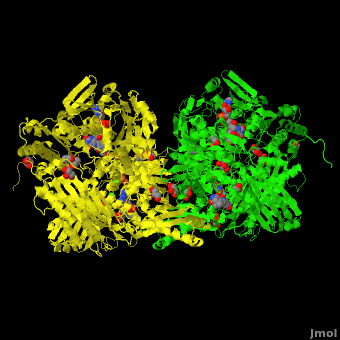Function
Xanthine dehydrogenase or xanthine oxidoreductase or Xanthine dehydrogenase/oxidase (XDH) is a molybdenum-containing hydroxylase involved in oxidative metabolism of purines. It catalyzes the conversion of xanthine to urea using NAD as hydrogen acceptor.
Several co-crystal structures of xanthine oxidase and xanthine dehydrogenase (which do not differ in conformation of active site) were studied to understand key interactions for enzyme inhibition. Docking of novel hits and inactive compounds was performed (to in PDB with ID 1vdv) to understand the ligand-protein interactions and hence, for structure-based design of more potent molecules.[1] The paper reports the directions for modification of the hit compound derived from these considerations, which are reported below. The mechanism of action of the novel hits are like and (“pure inhibitors”) and not like & FYX-051 (“substrate inhibitors”).
Xanthine oxidoreductase (XOR), is an oxidoreductive enzyme that is synthesized as xanthine dehydrogenase (XDH) and can be converted reversibly or irreversibly to xanthine oxidase (XO) form. It catalyzes the such as and which is excreted by kidneys.[2] The reaction occurs at the center from where the in case of XDH (PDB code 2w3s)[3] or to molecular oxygen in XO leading to the formation of superoxide anion and H2O2. Excessive production and/or inadequate excretion of uric acid results in hyperuricemia and is associated with conditions like gout, cardiovascular mortality and metabolic syndrome including hyperinsulinemia and hypertriglyceridemia. Alleviating hyperuricemia, therefore, has therapeutic significance, and XO is a key target towards this end.
Piraxostat (PDB code 1vdv) [4] and febuxostat (PDB code 1n5x)[5], show several interactions with the active site residues of the protein. The carboxyl group of piraxostat is involved in and as well. The ring nitrogen is involved in . The cyano group of the ligand forms another . Besides these polar interactions, a number of hydrophobic interactions are observed as well. The heteroaromatic ring is . The phenyl ring has hydrophobic interactions with . The alkoxy side chain extends towards the solvent accessible region and is engaged in hydrophobic interactions with various residues at the entrance of the pocket such as . Piraxostat is in green, Mo-Pt is in deep-sky-blue, residues are colored according to the type of interaction with ligand – salmon for pi-stack, magenta for other hydrophobic and cyan for polar interactions.
have been observed by docking our isocytosine series of compounds. The pyrimidine ring (compound 1 is shown). Highly polar groups such as –OH on pyrimidine ring correspond to carboxylate of piraxostat and retain . The –NH2 group in the same ring , which seems to play the role of anchoring the molecule in appropriate pose in the active site. The methoxy group shows a few of the several observed for piraxostat and febuxostat. in the interactions of Compound 1 and piraxostat can help in structure-based design to improve activity of isocytosine series.
Currently approved drugs for xanthine oxidase inhibition are allopurinol and febuxostat. Although both bind to the xanthine-binding site of XO, they work by different molecular mechanisms of action. Allopurinol acts as a substrate that is metabolized via hydroxylation to oxypurinol by Mo-Pt in the active site. Oxypurinol further inhibits the binding of xanthine by co-ordinating with Mo-Pt.[6] Febuxostat binds tightly in the active site and blocks the binding of xanthine, without interacting with Mo-Pt.[5] FYX-051 or topiroxostat currently in Phase II clinical trials also interacts with Mo-Pt just like allopurinol whereas piraxostat is akin to febuxostat.[7]
The mechanism of metabolism of substrate by XO requires that an electrophilic carbon next to a ring nitrogen of the substrate be positioned adjacent to Mo-Pt, with nitrogen towards Glu1261. Glu1261 acts as a general base and abstracts a proton from Mo-Pt hydroxyl group. The ionized Mo-Pt facilitates nucleophilic attack on the electrophilic carbon center. This type of motif is seen in the substrate inhibitors, allopurinol and FYX-051.[7] Febuxostat and piraxostat do not possess this motif and do not get metabolized by Mo-Pt.
Our hit has a novel isocytosine scaffold that has a nitrogen in the desired position, but the carbon is substituted with –NH2, and is not available for attack by Mo-Pt. Hence our compounds are "pure inhibitors" and not "substrate inhibitors".
Aromatic aldehydes at the active site of Aldehyde Oxidoreductase from Desulfovibrio gigas: Reactivity and Molecular Details of the Enzyme-Substrate and Enzyme-Product Interactions [8]
Desulfovibrio gigas aldehyde oxidoreductase (DgAOR) is a mononuclear molybdenum-containing enzyme from the xanthine oxidase (XO) family, a group of enzymes capable of catalyzing the oxidative hydroxylation of aldehydes and heterocyclic compounds. The kinetic studies reported in this work showed that DgAOR catalyzes the oxidative hydroxylation of aromatic aldehydes, but not heterocyclic compounds. NMR spectroscopy studies using 13C-labeled benzaldehyde confirmed that DgAOR catalyzes the conversion of aldehydes to the respective carboxylic acids. Steady-state kinetics in solution showed that high concentrations of the aromatic aldehydes produce
substrate inhibition and in the case of 3-phenyl propionaldehyde a suicide substrate behavior. Hydroxyl-substituted aromatic aldehydes present none of these behaviors but the kinetic parameters are largely affected by the position of the OH group. High-resolution crystallographic structures obtained from single crystals of showed that the side chains of Phe425 and Tyr535 are important for the stabilization of the substrate in the active site. Atoms color code: Mo in light teal, S in yellow, O in red, C in cyan (or gray). The benzaldehyde molecules B1 and B2 were modeled in two alternative conformations (orange/green and navy/violet,
respectively) On the other hand, the X-ray data of showed a cinnamic acid molecule in the substrate channel. In orange an alternate conformation of the side chain of Phe425 and a molecule of trans-cinnamaldehyde. The X-ray data of showed clearly how high substrate concentrations inactivate the enzyme by binding covalently at the surface of the enzyme and blocking the substrate channel. The different reactivity of DgAOR versus aldehyde oxidase and XO towards aromatic aldehydes and N-heterocyclic compounds is explained on the basis of the present kinetic and structural data.
3D structures of xanthine dehydrogenase
Xanthine dehydrogenase 3D structures

